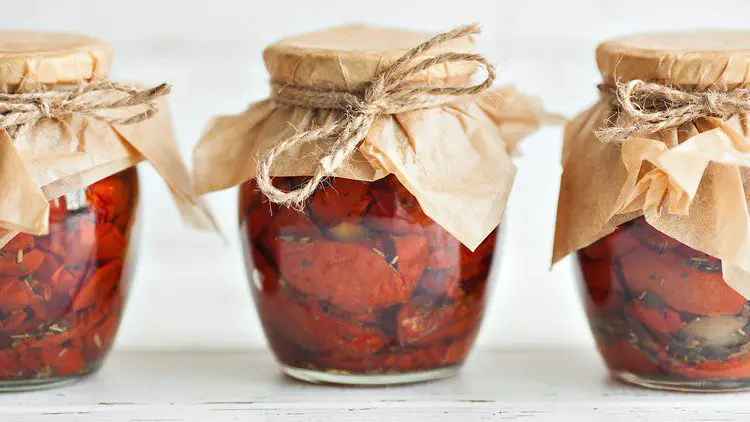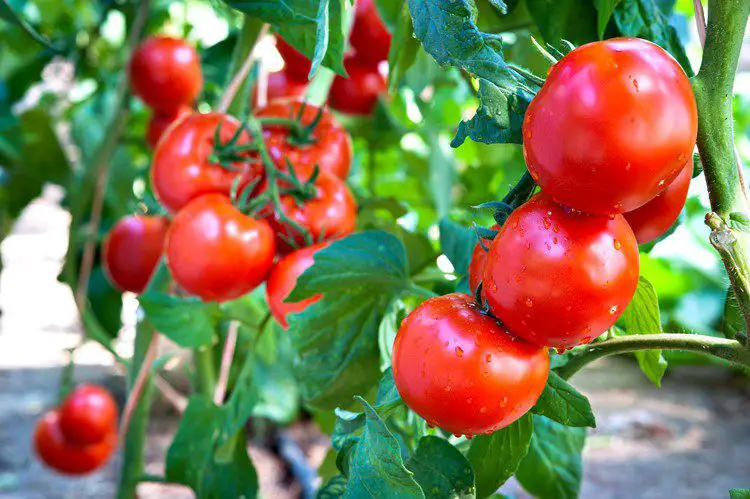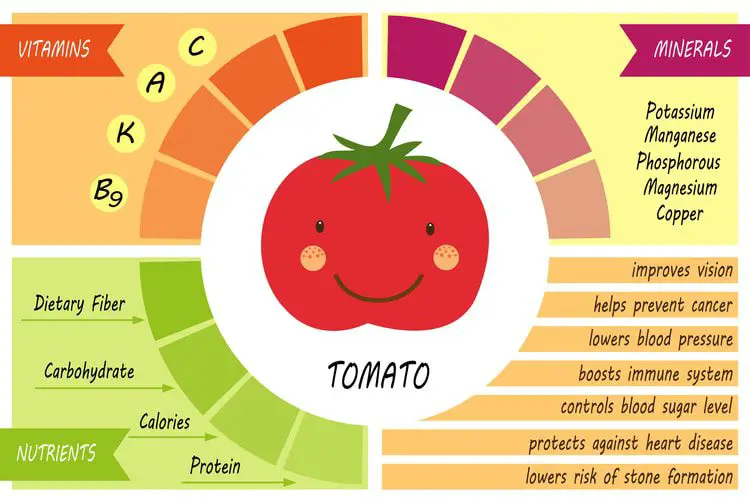There are many signs of summer, and one of the best is a plate of ripe tomatoes.
If you grow them in the summer, you know how unrelenting they can be. If you know how to dehydrate and preserve tomatoes, you can do something very useful with all that harvest.
A cornerstone of Italian cooking, the tomato is actually a fruit! From the best sauce to fresh slices of tomato, there is nothing really like a tomato when it’s ripe.
Don’t be fooled, though, dehydrated tomatoes, particularly sun-dried tomatoes, are a powerful asset for preparedness.
Growing fresh tomatoes is not as hard as you might think. In fact, if you get a harvest going, then tomatoes are going to be coming out of your ears. They are so prolific that it can be overwhelming.
Did I mention the lycopene and other health benefits? Tomatoes are one of the best vegetables to preserve and add to your food storage arsenal.
How to Dehydrate Tomatoes
 There are several ways that you can dehydrate tomatoes. However, three methods work the best and are most commonly used.
There are several ways that you can dehydrate tomatoes. However, three methods work the best and are most commonly used.
You can dehydrate or dry tomatoes in a countertop dehydrator, in your own oven, or by using the power of the sun.
Note that these methods can be used, no surprise, to make sun-dried tomatoes as well.
I’m going to share my favorite recipe, but first, let’s touch briefly on how to prep your tomatoes.
Preparing Tomatoes for Dehydration
 There are many varieties of tomatoes in our world. Some may be as big as softballs or as small as grapes.
There are many varieties of tomatoes in our world. Some may be as big as softballs or as small as grapes.
My preferred tomato to dehydrate is a Roma tomato. They have more meat and fewer seeds than your larger, rounder varieties. Likewise, they are great for drying as they are less juicy.
Roma tomatoes should be cut in half, not sliced, and dehydrated with the cut side up (skin side down). This retains the juices and sugars within the skin instead of draining this bounty into the pan. Nice!
Larger varieties can be sliced about ½ inch across.
The most important part of processing your tomatoes is to do so consistently. Dehydrate one type at a time, and be sure that all of the pieces are uniformly dried.
Remember, a thicker slice of tomato will take longer to dehydrate than a thinner one.
Finally, don’t forget to save some of those tomato seeds. You can grow a tomato from a tomato!

How to Dehydrate Tomatoes in a Dehydrator
If you are going to take on things like canning, dehydrating, and preserving you need to invest in a quality food dehydrator. The countertop dehydrator is the homesteader's best friend and can wonderfully preserve your tomatoes for long term storage.
Ingredients
- 1 pound tomatoes
Instructions
- Rinse the tomatoes and allow to dry
- Slice Roma tomatoes in half, or larger tomatoes in ½ inch slices
- Remove seeds for planting!
- Arrange cut side up (skin side down) on your dehydrator tray
- Lightly greasing the tray can help with the drying process
- Sprinkle with salt and basil (or your favorite herb)
- Preheat dehydrator to 140° F
- Dehydrate tomatoes for around 10 hours. Drying time will vary depending on the size and juiciness of your tomatoes, so check them starting at around the 7-8 hour mark.
- Remove tomatoes when they reach your preferred level of doneness, some may be ready quicker than others.
Notes
If you are looking for more of a meaty texture, like sun-dried tomatoes, you may want to pull them out around 7 hours. If you want a flexible, yet dried texture, allow tomatoes to dry closer to 10-12 hours.
See our Ultimate Food Dehydrator Guide and see which food dehydrator is best for you!
How to Dehydrate Tomatoes in an Oven
 Before shutting the doors at a restaurant I used to work at, we would dump about 5 pounds of grape tomatoes into a hotel pan and cover them with olive oil. We would roll them around and hit them with a little salt.
Before shutting the doors at a restaurant I used to work at, we would dump about 5 pounds of grape tomatoes into a hotel pan and cover them with olive oil. We would roll them around and hit them with a little salt.
With the oven turned off, a combination of the pilot light and 12 hours would dry these tomatoes beautifully. This was how I learned to dry tomatoes in the oven. We called them tomato raisins, and they were dropped into dishes to add amazing flavor!
It is a very simple, hands-off process to dry tomatoes in your oven.
Start by preheating your oven to the WARM setting. If your oven is too hot, you will burn the tomatoes over the long period of time they are inside. Like I mentioned above, you can simply dry them in the oven with just the pilot light on.
With something as wet as tomatoes, you might want to lay your slices out on a Silpat mat or wire rack.
Avoid laying them on parchment or aluminum foil if you can. They will adhere to the material, and you will have bits of foil or paper in your dehydrated tomatoes. Yuck.
Dehydrate them for about 12 hours and check the level of dryness. If they are still a little moist, you will want to return them to the oven for another hour or two.
How to Make Sun-Dried Tomatoes
 Sun-dried tomatoes are how our ancestors would have dried tomatoes through the ages. This process is a little different and works best with smaller tomatoes.
Sun-dried tomatoes are how our ancestors would have dried tomatoes through the ages. This process is a little different and works best with smaller tomatoes.
While you could use a solar oven to make sun-dried tomatoes, the very best way is to use twine, a needle, the sun, and wind. All of these combine to make something very special.
It will take days for you to dry the tomatoes this way, but there is nothing like true sun-dried tomatoes.
Using your needle, thread the twine through the thickest parts of your tomatoes. Halved tomatoes are best for this. If you have very big tomatoes, you may need to quarter them.
Using a foot of twine or string, you want to thread your needle and twine through about 10 pieces of tomato.
Hang the string of tomatoes outside in an area that gets plenty of sunlight. Warm days and a nice breeze can help things along, but you are going to need every bit of 3-5 days to get these tomatoes sun-dried.
Dehydrated Tomatoes vs Sun-Dried Tomatoes
Dehydrated tomatoes are dry, with little to no moisture left in them. On the other hand, sun-dried tomatoes are less dried and still have a meaty texture to them. They are a magical ingredient, and many great recipes include sun-dried tomatoes.
Remember, since sun-dried tomatoes contain more moisture, they will be stored in oil rather than just shoved into a Mylar bag together.
How to Store Dehydrated Tomatoes for the Long Term
 After you have dehydrated or sun-dried tomatoes, its time to consider storing them for the long term. You are going to do this in two different ways.
After you have dehydrated or sun-dried tomatoes, its time to consider storing them for the long term. You are going to do this in two different ways.
Sun-Dried Tomatoes
These sun-dried tomatoes are going to be stored in oil for the long term. Mason jars and high-quality olive oil will create a lasting environment for long-term storage.
Dehydrated Tomatoes
The best way to store these for the long term will be to use Mylar bags, oxygen absorbers, small plastic buckets, or even larger mason jars.
The oil will act as a preservative, as will the oxygen absorbers and mylar bags.
You want to be sure that you keep your sun-dried tomatoes out of direct sunlight. This could make the oil go rancid and spoil what’s inside.
Ball Mason 32 oz Wide Mouth Jars with Lids and Bands, Set of 12 Jars. (Limited Edition) Colavita Extra Virgin Olive Oil, First Cold Pressed, (2 Liters) 68 Fl Oz (Pack of 1)
Colavita Extra Virgin Olive Oil, First Cold Pressed, (2 Liters) 68 Fl Oz (Pack of 1) 20 – 1 Quart Mylar Bags & Oxygen Absorbers for Dried Food & Long Term Storage by Dry-Packs!
20 – 1 Quart Mylar Bags & Oxygen Absorbers for Dried Food & Long Term Storage by Dry-Packs!
How Long Will Dehydrated Tomatoes Last?
If you store sun-dried tomatoes in oil, you are going to hold onto those as long as the oil is fresh.
Rancid oil will cause the food it’s stored in to go rancid as well. There is no washing rancid oil off. The shelf life of olive oil can be quite long if you store the jars in a cool, dark place.
I would check the tomatoes yearly. You will likely burn through your sun-dried tomatoes before they go bad. That is the beauty of rotation.
As for the dehydrated tomatoes, you are going to get a much longer storage period. Due to the lack of oxygen and moisture in the mylar bag environment, it becomes next to impossible for bacteria to grow.
This means you can keep dried foods for as long as 20 years! That is some serious shelf life!
Growing Tomatoes
Tomatoes are from the Mediterranean, and that means they prefer a climate that matches the area. When you know how to grow tomatoes, you will reap the benefits.
How to Grow Tomatoes
 Tomatoes require several different things to be successful. All of which are very easy, but if you do not act as a conscientious gardener, you will struggle to have a good harvest.
Tomatoes require several different things to be successful. All of which are very easy, but if you do not act as a conscientious gardener, you will struggle to have a good harvest.
Watering
Tomatoes are Mediterranean plants, and they like moisture. They can stand that heat, but they like the moisture to boot.
Deep root watering is very necessary. My father-in-law buries PVC pipes in the ground and leaves a length of them exposed above the ground to dump water directly into that deep root system. His tomatoes grow to be about 10 feet tall each year.
Managing Sun
The sun can be a double-edged sword. While lots of sun in the early days of growing can be great, hot temperatures and the glaring sun can take a toll on your plants in July and August.
8 hours of sun are going to be important when it comes to growing big red tomatoes. In the summer, you might want to cover them with some thin cloth to block the sun.
Disease
Trimming your tomato plants is going to give you the ability to keep the leaves off the soil.
They pick up all kinds of problems from the ground. From pests to disease, your leaves are going to cause all sorts of trouble.
In fact, trimming most of the lower leaves on your plant will focus nutrients on the higher leaves and tomatoes.
Nutrient-Dense Soil
Tomatoes take up a lot of nutrients from the soil. To make big, red, ripe tomatoes, they need a lot of nutrients!
It’s important to replace that soil year over year and even give it some rest. You can learn how to plant tomatoes in grow bags or pots if you can manage the soil and watering.
Things like compost and azomite are powerful organic solutions that can aid in the replacement of nutrients in the soil.
Fertilizer
Even with nutrient-dense soil, you are going to need to fertilize your plants. The biggest and strongest plants are fertilized. How you fertilize is an interesting question.
You can buy pre-made fertilizer that is manure-based. That’s for sale at most department stores.
Here are a few other methods to consider:
- Hydrolyzed fish emulsion is an organic, less harmful solution to fertilizing.
- You could also make some compost tea, which is a great alternative.
- If you compost your chicken poo, you will unleash another powerful fertilizer on your soil and plants.
Use a Trellis!

Your tomatoes are vining plants. You may not see it until you unleash them on high-reaching trellises. These can be made from several different materials. It is very easy to make a DIY trellis system.
Most backyard gardeners grow tomatoes every year, but some people do an amazing job growing them year over year. They take advantage of the many things we talked about above.
Health Benefits of Tomatoes

The benefits of eating tomatoes are wide-ranging. The men on the island of Crete live and work into their 90s!
They exist on a diet heavy on red wine, seafood, olive oil, and tomatoes. The proof is in the pudding.
So, what are the health benefits of tomatoes? Let’s have a look.
Vitamin C
How does 40% of your daily recommended vitamin C sound? You get that in one tomato! These ruby reds are filled with a wide range of vitamins and minerals.
Additionally, higher consumption of vitamin C is associated with a lower risk of most types of cancer.
Fights Carcinogens
In our daily lives, we are under assault from a variety of deadly carcinogens. To combat this, tomatoes are packed with high levels of vitamin A which will combat their harmful effects.
Improves Vision
Those same high levels of vitamin A also improve vision. This is another huge benefit of eating tomatoes.
Aids Digestion
Because of the skin and flesh in the tomatoes, you receive a healthy boost in your fiber intake. This feeds the helpful bacteria in the lower gut and aids the entire digestive process.
Lowers Blood Pressure
The high levels of potassium in tomatoes, which can help you with your hypertension. Potassium is a vasodilator that helps with constricted blood flow.
Weight Loss!
Their high fiber content and nutrient-dense makeup mean that tomatoes are going to help with weight loss. You can swap out unhealthy snacks for something like cherry or grape tomatoes!
It should come as no surprise that tomatoes are such a healthy food. There is a reason they find their place in the backyards of almost every gardener.
Learning how to grow tomatoes makes a world of difference in the amount you have to harvest and how you dehydrate your tomatoes.
Conclusion
Tomatoes are a macrofood! They are a tremendous part of our culture and our diet, and they are abundant with nutrition.
There are also many ways that you can grow tomatoes. Additionally, you can grow them all over the world!
Tomatoes are a diverse crop that can be grown in even the most hostile environments. If you know how to grow these, it can make a huge difference during your harvest.
Whether you sun-dry or dehydrate them, tomatoes are great to preserve and deserve a place in your food storage pantry.



